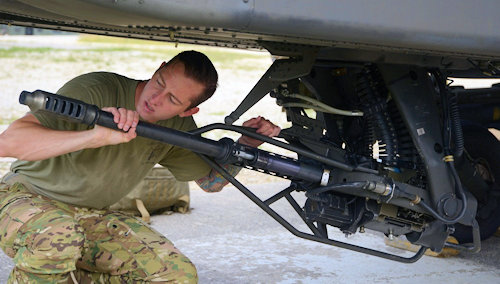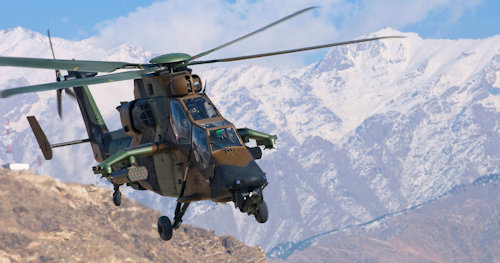Entered into service in the 1984 with the US Army in 812 specimens,Apache has been subjected during its operational life to a series of interventions designed to improve its reliability by reducing its complexity, improvements that resulted in the AH-64D version with radar Longbow placed above the rotor shaft.
The aircraft is a technology and power concentrate. Just think that with a full load of fuel, plus a 870 liter tank, two crewmen, 16 laser-guided missiles AGM-114 Helfire, 19 rockets Hydra from 70 mm and 600 shots for the M-230 cannon Chain Gun by 30 mm (for a total weight of 9.000 kg), the AH-64D may remain half an hour in the operating area at a distance of 305 km from the base and return with about 20 minutes of reserve fuel.
Target Acquisition and Designation Sight (TADS) and Pilot's Night Vision System (PNVS) are located on the government; the avionics in the two guance side and the sensor for low speed targets above the rotor hub; the 30 mm cannon is fed with the ammunition stored in the fuselage.

The engines, two 700 shp General Electric T701-GE-1.890Cs with a cruising speed of 261 km / h (the British Army version is equipped with Rolls Royce RTM322 engines from 2.100 shp), are spaced apart they operate a four-blade main rotor whose ends have an 20 ° arrow while the tail rotor has the four crossed blades to 55 ° to reduce noise.
The pilot has two 150x150 multimode screens with basic controls at your fingertips. The radar position above the rotor hub causes the helicopter to control the battlefield and identify the targets while remaining with the indoor fuselage, furthermore, the radar Longbow of HAHA-64D, allows for a quick examination of the tactical situation even in adverse weather conditions.
Designed in the 1972-1973 biennial on US Army specifications for an Advanced Attack Helicopter (AAH), the cell consists of a large flat sheet metal shell with boron armor, stainless steel rotor and multiple fiber rotor blades able to withstand shocks from 23 mm of Soviet septic tank ZSU-23-4 Shilka.

The European "competitor"
On the European side, the Eurocopter Tigre (for the French) or Tiger (for the Germans) represents the answer to the H-64. Aircraft production began in 2003, with the French HAP version (Hélicoptère d'Appui et de Ptrotection).
The weight in combat order of the Tigre is of 5.300 / 5.800 kg, while the propulsion is ensured by two 390 MTR 1,171 shp and 1.285 continuous max. The HAP version, intended for air-to-air combat and fire support, is equipped with a GIAT NC 621 cannon from 30 mm, 28 68 mm unmanned rockets and four air-to-air missiles Mistral.
The UHT (Unterstützung Hubschrauber Tiger) Multiruolo version features sensors (IIR, TV and laser range finder) above the rotor hub and can carry up to 8 countercars Spike ER and four air-to-air missiles Stinger.
Large amounts of composite materials (up to the 80%) are used in the cell while in the carlinga the pilot is in the front position with the copilot / cannoniere in the raised posterior position. The dashboard is dominated by two large screens - piled for the pilot and superimposed for the copilot - and by other differentiated tools.

In the HAP version, the mission support equipment, SFIL / Stryx, is placed in one dome gyrostabilized placed above the roof behind the co-pilot; the sensor contains the day and night vision sensor. On the rotor hub a doppler DAV pulsar radar is installed that can target targets up to 7 km.
Il Tigre is a plane of size and therefore of potential inferior to the HA-64D Longbow (the latter would be able to carry up to 16 countercars Helfire against the eight of Tigre). However, the European helicopter records a lower maintenance cost than the "Apache.
Certainly, while AH-64D has demonstrated its potential in the difficult operations - both operationally and climatic - such as Afghanistan and Iraq, the Tigre has not received the baptism of fire. The reasons why the British Army (with 67 specimens) and the Dutch Army (with 30 specimens) opted for the adoption of the helicopter produced by Boeing were obvious.

(photo: US Air National Guard / US Army)












